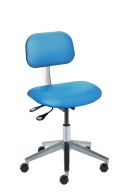Choosing the right laboratory chairs for your workspace is a crucial decision that directly impacts the productivity, safety, and overall well-being of laboratory personnel. A well-designed and ergonomic laboratory chair not only enhances comfort but also promotes efficient workflow and reduces the risk of work-related injuries. However, with a wide range of options available in the market, it can be overwhelming to find the perfect fit for your specific lab environment. In this article provided by Global Lab Supply, we will explore the essential factors to consider when selecting laboratory chairs, including the importance of ergonomic design, understanding the unique needs of your lab, assessing key features, exploring different types and styles, budget considerations, compliance with industry standards, and best practices for maintenance. By understanding these crucial aspects, you will be able to make an informed decision to create a safe and productive laboratory workspace.
Understanding the Impact of Comfortable and Supportive Chairs
When it comes to laboratory work, we often focus on the equipment and tools we use, but what about the chairs we sit on? Comfortable and supportive chairs are not just a luxury; they are a crucial factor in maintaining productivity and ensuring the safety of lab workers.
Sitting for long periods in chairs that lack proper support can lead to fatigue, discomfort, and even chronic pain. On the other hand, ergonomic chairs are designed to provide optimum comfort, reducing the risk of musculoskeletal disorders and improving overall well-being.
Enhancing Productivity through Ergonomic Design
Have you ever found yourself fidgeting in your chair or constantly readjusting to find a comfortable position? This not only distracts you from your work but also slows you down. Ergonomic laboratory chairs offer adjustable features, such as seat height, backrest tilt, and armrests, allowing you to find your ideal working position. By minimizing discomfort and promoting a healthy posture, these chairs can boost your productivity and focus.
Promoting Safety and Reducing Workplace Injuries
Lab environments can be hazardous, with the presence of chemicals, delicate equipment, and potential accidents. The last thing you want is an unstable or flimsy chair that puts you at risk of falls or injuries. Ergonomic laboratory chairs are built with stability and durability in mind. They come equipped with sturdy bases, non-slip casters, and robust materials to ensure your safety. By investing in the right chairs, you can significantly reduce workplace injuries and create a safer working environment.
Understanding the Specific Needs and Requirements of Your Lab Environment
Identifying the Nature of Lab Work and Tasks
Not all laboratories are the same, and neither are their chair requirements. It is crucial to assess the specific needs and tasks performed in your lab. Are you working with delicate instruments that require precise movements? Or are you conducting more general lab work that involves frequent movement and collaboration? Understanding these factors will help you choose chairs that cater to your lab’s unique demands.
Analyzing Space and Layout Constraints
Laboratories often have limited space, which means you need to take into consideration the chairs’ dimensions and how they fit into your workspace. Opt for chairs that are compact and can be easily maneuvered without obstructing pathways. Additionally, consider the layout of your lab and whether you require chairs that can fit under countertops or workstations.
Considering Cleanroom and Chemical Resistance Requirements
If your lab operates in a cleanroom environment or deals with chemicals and potential spills, it is essential to choose chairs that meet the necessary cleanliness and chemical resistance standards. Look for chairs made from materials that are easy to clean and disinfect without compromising their structural integrity. This ensures a hygienic and safe working environment.
Key Factors to Consider when Selecting Laboratory Chairs
Adjustability and Customization Options
Everyone’s body is unique, so it’s crucial to have chairs that can be adjusted to suit individual preferences. Look for chairs with adjustable features like seat height, backrest tilt, and armrests. This allows you to find the perfect fit and maintain a comfortable working posture throughout the day.
Material Selection for Durability and Cleanability
Laboratory environments can be tough on chairs, with spills, chemicals, and regular wear and tear. Choose chairs made from durable materials that can withstand frequent use and cleaning without losing their structural integrity. Additionally, opt for chairs with upholstery that is easy to clean and resistant to stains and microbial growth.
Weight Capacity and Stability
Ensure that the chairs you select have a weight capacity suitable for your lab’s requirements. Overloading a chair beyond its capacity can result in accidents and damage to the chair. Look for chairs with sturdy bases, reinforced frames, and non-slip features to maximize stability and prevent falls.
Exploring Different Types and Styles of Laboratory Chairs
Task Chairs for General Lab Work
Task chairs are versatile and suitable for various lab tasks. They offer adjustable features, including seat height and backrest tilt, and come with or without armrests. Task chairs are a popular choice for their comfort and flexibility, allowing lab workers to focus on their work without distractions.
Sit-Stand Chairs for Flexible Working Positions
For labs that require frequent transitioning between sitting and standing positions, sit-stand chairs are ideal. These chairs offer height adjustability, allowing you to effortlessly switch between different working postures. By promoting movement and reducing sedentary behavior, sit-stand chairs contribute to a healthier and more dynamic lab environment.
Stool Chairs for Laboratory Technicians
Lab technicians often require stable and maneuverable seating options that offer freedom of movement. Stool chairs are a popular choice in laboratories due to their compact design and swivel capabilities. Look for stool chairs with ergonomic features like height adjustment and footrests to provide technicians with the support they need during their tasks.
Remember, choosing the right laboratory chairs goes beyond aesthetics. Prioritize comfort, safety, and functionality to create a productive and safe workspace for yourself and your lab team. Happy sitting!
Assessing Durability, Comfort, and Adjustability Features
When choosing laboratory chairs for your workspace, it’s essential to consider durability, comfort, and adjustability features. After all, you’ll be spending a significant amount of time sitting in these chairs, so you want them to be comfortable and supportive.
Evaluating Chair Frame and Base Construction
Start by examining the chair’s frame and base construction. Look for chairs made from sturdy materials like steel or aluminum, as they offer durability and stability. Avoid chairs with cheap plastic components that may break easily.
Additionally, check if the chair has a stable base with a five-point design. This design ensures proper weight distribution and prevents tipping when you shift your position.
Examining Seat and Backrest Materials
Next, pay attention to the seat and backrest materials. Look for chairs with high-quality upholstery that is easy to clean and resistant to spills. Materials like vinyl or synthetic leather are often a good option in laboratory settings. They are durable, easy to wipe down, and resistant to chemicals.
Additionally, consider chairs with cushioned seats and contoured backrests for added comfort and support during long hours of work.
Considering Armrests, Footrests, and Additional Features
Armrests and footrests can significantly enhance comfort during extended periods of sitting. Look for chairs that have adjustable armrests to ensure proper positioning that supports your arms and reduces strain on your shoulders.
Consider chairs with footrests if you spend a lot of time working at elevated benches. They can help reduce leg fatigue and improve overall posture.
Moreover, some laboratory chairs come with additional features such as adjustable height, tilt mechanisms, and lumbar support. Assess which features are important to you and choose accordingly.
Considering Budgetary Constraints and Long-Term Investment
While it’s tempting to solely focus on price when choosing laboratory chairs, it’s important to consider long-term investment and quality.
Setting a Realistic Budget Range
Determine a budget range that suits your organization’s financial constraints. Remember, investing in high-quality chairs is crucial to ensure comfort, durability, and safety for your staff. Finding a balance between cost and quality is key.
Weighing Cost versus Quality and Durability
Consider the lifespan of the chairs and the potential costs of replacing them frequently. It might be more cost-effective to invest in slightly more expensive chairs upfront that will last longer, rather than buying cheaper chairs that will deteriorate quickly.
Consider the warranty provided by the manufacturer. A longer warranty period can indicate better quality and give you peace of mind.
Ensuring Compliance with Industry Standards and Regulations
In a laboratory setting, compliance with industry standards and regulations is crucial for safety and legality.
Understanding Relevant Regulations and Guidelines
Familiarize yourself with the specific regulations and guidelines relevant to your industry. Different standards may apply, depending on whether you work in a medical, chemical, or research laboratory. Ensure that the chairs you choose meet or exceed these requirements.
Verifying Certification and Compliance Labels
Look for chairs that have certification labels from recognized organizations or agencies. These labels indicate that the chairs have been tested and meet specific safety standards. Common certifications to look for include ANSI/BIFMA for general office chairs and CAL 133 for fire safety.
Tips and Best Practices for Maintaining Laboratory Chairs for Optimal Performance
To keep your laboratory chairs in top-notch condition, follow these maintenance tips:
Establishing Regular Cleaning and Maintenance Protocols
Create a cleaning and maintenance schedule to ensure your chairs remain clean and functional. Regularly wipe down the chairs with a suitable cleaning solution or disinfectant, especially in high-traffic areas. Inspect the chairs for any signs of wear and tear, loose screws, or damaged components, and address them promptly.
Remember, proper maintenance not only extends the lifespan of your chairs but also enhances their performance, keeping you and your team comfortable and safe during work hours.
Now that you’re armed with these guidelines, go forth and choose laboratory chairs that are not only practical but also inject a bit of comfort and style into your workspace. After all, who says science can’t be stylish? In conclusion, choosing the Global Lab Supply laboratory chairs for your workspace is a decision that should not be taken lightly. By prioritizing ergonomics, understanding your lab’s specific needs, considering key factors, exploring different options, and ensuring compliance, you can create a comfortable and safe environment for your lab personnel. Remember to also budget wisely and maintain your chairs regularly to ensure optimal performance. With the guidance provided in this article, you are equipped to make an informed choice that promotes productivity, safety, and overall well-being in your laboratory.














